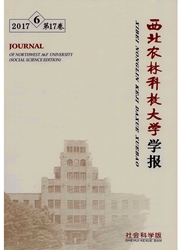

 中文摘要:
中文摘要:
自1999年退耕还林实施以来,在生态恢复以及社会经济方面都产生了显著的成效,探讨退耕还林工程具体实施效益成为当前研究热点。通过从生态、经济、社会三个方面建立退耕还林工程综合效益评价分析框架及指标体系,并采用客观的Meta分析方法,对220篇关于退耕还林工程效益评价的文献进行分类整理评价。实证研究结果表明:退耕还林工程在固土保肥方面的效益得到广泛认可(30.4%),工程实施区土地植被覆盖度得到迅速提高(17.7%),同时在固碳制氧、生物多样性、涵养水源等方面也有一定的成效;退耕还林工程的社会经济效益方面,在当地农户收入的影响方面具有较大的争议,工程实施后因补贴收入增加、释放劳动力、林业收入等方面实现收入增加的同时(35.46%),不少研究仍表示因土地占用而导致了种植业收入的下降(8.2%);同时退耕对促进项目区农业种植结构调整(20.9%)、就业结构调整(11.4%)、产业结构调整(6.82%)等方面的作用均得到验证。依据对文献的分析与展评,未来研究中需关注如何实现现有成果有效巩固,以及如何制定更完善的体系对后续退耕区域先后选择进行评估等关键问题。
 英文摘要:
英文摘要:
Since the implementation of Sloping Land Converting Program(SLCP)in 1999,remarkable effect has been achieved on ecological restoration,and social and economical benefits.This article builds the benefits evaluation analysis framework and index system through three aspects of ecology,economy and society of SLCP.Based on the Meta analysis method,220 articles about SLCP's benefit evaluation are classified.The results showed that:the benefits of SLCP in soil conservation are widely recognized(30.4%),the land vegetation coverage is increased in the implementation area(17.7%),there are also some achievements in terms of carbon fixation and oxygen production,biodiversity,water conservation etc.As for the effect of the program on local farmers' income,there is certain controversy,some think that the implementation of the program increased their income due to subsidies,release labor and forestry revenue(35.46%),while other studies show that there is a decline in the income from farming for land use decrease(8.2%).At the same time,the SLCP promoted the adjustment of agricultural planting structure(20.9%),the employment structure(11.4%),the industrial structure(6.82%)and others.According to the analysis and development of the literature,we should pay attention to the effective consolidation of the existing results and use a more perfect system to evaluate the regional selection of SLCP.
 同期刊论文项目
同期刊论文项目
 同项目期刊论文
同项目期刊论文
 期刊信息
期刊信息
